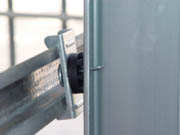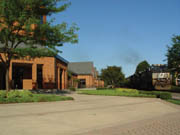I have seen changes made to structural, lighting, electrical, mechanical, plumbing, room finishing and hardware cause unacceptable background noise levels, create standing echoes, produce annoying peak resonance and create various other acoustic anomalies. Most of these acoustic problems are built into the building, and cannot be repaired without great expense. Wishful thinking and off-the-cuff remarks often run counter with the laws of physics, and as any Trekker can tell you, "You cannuh change the laws of physics."
Cost is a common excuse for not following acoustics recommendations. Certainly, the initial cost can be much lower by excluding uncommon construction techniques and taking shortcuts in building components that won't be seen. And, the logic goes, one little change won't be noticed. The reality is that any good acoustic design is a chain that requires all of its component links to be there and to be strong. The acoustics are only as good as the weakest link.
Most building owners don't realize the true cost of not achieving good acoustics until their million-dollar condo tenants start suing because they can hear neighbors, or until a church's attendance drops because people can't hear over the HVAC, or until a generation of kids have graduated from a school without understanding half of what was said.
Achieving good acoustics is a team effort. Everyone involved in a building project is a team member and pushes the acoustics in some direction. Every building component either makes noise, blocks noise or absorbs noise. The biggest problem I see is that very few people know in which direction they should be pushing or even in which direction they are pushing.
Each space has an acoustic function and therefore, each should be given acoustic goals. These goals need to be established before the architect lays down the first line on the concept drawings-even before the site is selected. With acoustic goals already established, team members have a standard with which to judge each decision in the design/build process.
There are more than 80 different acoustic measures of a space but fortunately, only three are needed to give a solid foundation for excellent acoustics: background noise, speech intelligibility and reverberation/liveliness.

Background Noise
The scientific measure of silence in the noise criteria rating is a measurement of the humanly perceived background noise over the entire audible frequency range. Standard goals for NC ratings have been established for various types of spaces. Following is a list of recommended NC ratings:
Recording Studio NC10
Concert Hall NC15
Lounge NC40
Home NC25
Condo NC30
Hotel Room NC35
Office NC35
Church NC25
Classroom NC25
As an example, with the background noise goal established early, the real cost of a decision to locate a library next to a railroad track can be determined. The site may be relatively inexpensive and conveniently located, but the cost to isolate noise will be many times greater than any perceived savings in site cost. It will likely be an acoustic handicap that is physically impossible to solve: resulting in a library that is both more expensive to build and still too noisy. The building committee may still decide to locate the library here, but they will do it knowing full well what the extra costs and extra noise will be-and with an idea of how this will affect the function of the building.
Speech Intelligibility
Speech Intelligibility is simply a measure of how much of what is said is understood by those in attendance. Initially, this was accomplished by reading a list of words and having all in attendance write down what they thought they heard. Now, speech intelligibility can be quickly measured in existing rooms and estimated for planned spaces using computerization. The most common measurement system is the Rapid Speech Transmission Index, which was introduced as an international standard in 1987. The RASTI values for the range of conditions is given below.
Bad 0 to 0.3
Poor 0.3 to 0.45
Fair 0.45 to 0.6
Good 0.6 to 0.75
Excellent 0.75 to 1.00
Although there are no published standards, I recommend that all spaces achieve a speech intelligibility of RASTI 0.65 or above.

Reverberation or Liveliness
The length of time it takes for sound to die down in a room after its source has been shut off is reverberation time. For smaller rooms, sound does not fade away smoothly and so instead of reverberation, we talk about the liveliness of the room. Over the past century, surveys have been conducted to determine the preferred reverberation in various types of spaces. This has resulted in a set of curves that show the preferred range of reverberation as it varies with 1) type of space, 2) size of space and 3) frequency of sound.
The data is too complicated to reproduce here; however, I believe that it is sufficient to specify that all spaces be designed and shown to fall within the historically accepted limits for reverberation time for their size and use.
Beyond the Status Quo
Having decided the acoustic goals, and having paid the premium for the extra work and special materials needed to achieve those goals, the quality of construction is the critical link.It is only human nature to fall back into a "normal routine." This behavior is hard wired into our brains, and is a big factor for the survival of our species. Once learned, we can execute a complicated task with skill and precision, without thinking about it. Unfortunately, this also makes it difficult for us to make changes to our routine. (Anyone try to change his golf swing lately?)
Given that most acoustic constructions are not routine, it is very easy to mess them up by trying to make them fit our normal way of doing things. "This is the way we always do it" is a common false logic. If the acoustic goals are going to be achieved, all of the contractors and subcontractors must be seen as part of the team. And all of them must stop, think and plan their assemblies. Anyone left off the team can be a loose cannon; a plumber knocking an access hole through a sound barrier, a drywaller short circuiting resilient channel with long screws, a painter painting over an acoustic absorber.
Inspection and post construction testing is the final waypoint to achieve acoustic goals. If caught during an inspection, the fix usually means redoing one or two construction steps. If not caught until the post construction testing, a complete tear out may be necessary.
Achieving the acoustic goals of a project has both costs and benefits. Therefore, the acoustic goals must be thoughtfully chosen to optimize payback such as user satisfaction, membership growth, worker output, community reputation, attendance or ticket sales. Specifying the goals for background noise, speech intelligibility and reverberation for each space before the design begins is a simple way to build good acoustics into a project. Costs are controlled by not having to correct acoustic defects caused by design decisions made on false economies having no regard to their acoustic consequences.

